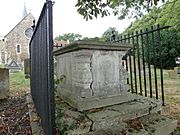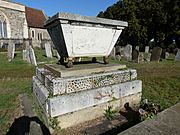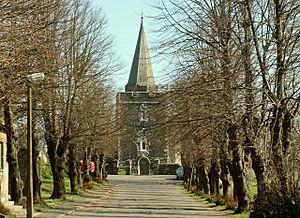All Saints Church, Frindsbury facts for kids
Quick facts for kids All Saints, Frindsbury |
|
|---|---|
 |
|
| Lua error in Module:Location_map at line 420: attempt to index field 'wikibase' (a nil value). | |
| Location | Rochester, Kent |
| Country | England |
| Denomination | Anglican |
| Website | http://www.allsaintsfrindsbury.co.uk/ |
| History | |
| Status | Parish church |
| Architecture | |
| Functional status | Active |
| Heritage designation | Grade II |
| Designated | 24 October 1950 |
| Architectural type | Church |
| Specifications | |
| Materials | Caen Stone and flint |
| Bells | 8 (full circle) |
| Tenor bell weight | 15 long cwt 2 qr 4 lb (1,740 lb or 789 kg) |
| Administration | |
| Parish | The Parish of Frindsbury with Upnor and Chattenden |
| Diocese | Rochester |
| Province | Canterbury |
All Saints, Frindsbury is a historic parish church located in Rochester, Kent, England. It serves the areas of Frindsbury, Upnor, and Chattenden. The church has been around since 1075 and is a very important building, listed as Grade II*. This means it's a special building that needs to be protected.
Contents
History of All Saints Church
Ancient Times in Frindsbury
Long ago, the Romans built a stone bridge over the River Medway and a road through the marshy land near Frindsbury. They likely had a large farming settlement here.
Later, in the 700s, kings and bishops owned the land around Frindsbury. After the Battle of Hastings in 1066, William the Conqueror gave the land to his half-brother, Odo. However, the land was eventually returned to the Bishop Gundulf of Rochester. Bishop Gundulf started rebuilding Rochester Cathedral and gave the land at Frindsbury to the new Benedictine monastery there.
The Church in the Middle Ages
It's not certain if there was a church in Frindsbury before the Normans arrived, but it's very likely. The first stone church was built around 1075. The Domesday Book of 1086, a famous survey of England, mentions the church.
In 1127, the church was rebuilt. This might have been a major repair rather than a brand new building. A small wooden church was also built in nearby Strood in 1122, which later became St Nicholas' parish church.
Over the centuries, there were some disagreements about who owned the church and its income, but it often remained connected to the Bishop of Rochester. More building work happened in the 1300s and early 1400s.
Modern Era Changes
During the English Reformation in the 1500s, many church decorations were removed or painted over. However, in 1883, old wall paintings of saints were discovered. The church was greatly repaired and updated in 1884, thanks to a generous donation from Mrs. Murray.
Church Architecture
Today, the church stands on top of chalk cliffs, making it easy to see from the Medway valley. It is surrounded by old graveyards.
Outside the Church
The church is built from a mix of flint and ragstone, with special Caen Stone used for details. Older parts are mostly flint and ragstone, while newer parts use more limestone. The church has a traditional shape with a rectangular chancel (the area around the altar), a nave (the main part where people sit), and aisles on both sides. The chancel, nave, and lower parts of the tower are from the Norman period. The tower's staircase and the south aisle were added in the 1300s. The north aisle was built or rebuilt in 1884.
The tower has a shingle spire on top, which is a pointed roof covered in wooden tiles. From the top, you can get amazing views, but it's not open to the public.
Notable Tombs
Several tombs in the churchyard are also listed as historic buildings.
- The Boghurst tomb from 1750 is a chest-shaped tomb near the south door. It has interesting carvings and inscriptions.
- The Moulding tomb from 1789 is another chest tomb, located to the east of the church.
- The Miller monument from the early 1800s is a sarcophagus-shaped monument with a unique "running dog" pattern.
The famous historian and archaeologist Charles Roach Smith (1807–1890) is buried here. There is also a group of 12 old headstones from the 1600s and 1700s.
Inside the Church
The main entrance is through the west end. The bottom part of the tower has been updated with cupboards made from old pews. Many of the tombstones on the floor were moved here after the church was rebuilt in the 1800s. The arch leading from the tower to the nave has a glass and oak screen. This screen lists the names of local people who died in World War I and World War II.
The nave, the main seating area, has been changed a lot over time. The floor is now tiled. A modern toilet and small kitchen have been added at the west end of the nave.
The south aisle is separated from the nave by three arches. The east window is modern, and the side windows were restored in the 1400s. A small basin in the south wall shows where the Lady Chapel used to be. The font, where baptisms take place, is from the early 1400s and is octagonal (eight-sided).
The north aisle was built in 1883.
The chancel, where the altar is, is entered through a wide Norman arch. The roof of the chancel has some original wooden beams. Traces of old windows and frescos (wall paintings) have been found in the side walls. The rose window in the east wall is a reconstruction of the original. Below it are three Norman windows that were once covered up. When they were uncovered, they had medieval frescos around them, which are now fading.
The Buttler Memorial
Near the font, there is a special wall monument from 1621 dedicated to Thomas Buttler. It has two panels. The left panel talks about Thomas Buttler's service to Queen Elizabeth I in different countries. The right panel records the burial dates of his two wives, Dennis and Margaret.
Ancient Frescos
The frescos discovered in 1883 have mostly faded away by 1990. A small copy of them hangs on the south wall of the chancel.
One window shows St. Leonard and St. Edmund Rich, who was an Archbishop of Canterbury. This is the only known mural of St. Edmund. Another window shows a haloed woman, possibly St. Mary Magdalene, and a pilgrim, who might be St. William of Perth. These paintings are thought to be from around 1256.
Church Music
The Organ
The church once had an organ above the main entrance. A new organ was built in 1889 and later moved. Sadly, in 2008, it was damaged by rainwater after metal was stolen from the roof. It was then sold. Now, music for services is provided by an electric organ and a group of young church members.
The Bells
The church has a set of eight bells that are rung in the English style. The oldest bell, number 6, was first cast in 1260! Other bells were cast in 1584, 1637, and 1638. In 1920, some old bells were recast, and three new ones were added to make a total of eight. In 2000, one of the older bells was found to have a poor sound. As part of a project supported by the Millennium Commission, a new bell named "Carole" was cast.






